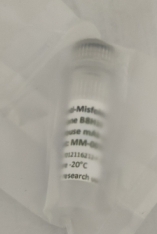 首页>
生物试剂
首页>
生物试剂
商家描述
产品评价(0)
Target
Substance P
Target background
This antibody is a bispecific monoclonal antibody capable of simultaneously recognize the horseradish peroxidase (HRP) and Substance P. Bi-specific monoclonal antibodies have been successfully used in one step immunocytochemistry and immuno-dot assays. These results demonstrated that bispecific antibodies can be applied in quick and simple staining procedures and provide intense immunostaining. The P4C1 antibody has been successfully used in immunoassays and immunohistochemistry. Light and electron micrographs of rat tissue developed using this antibody clearly demonstrate substance P immunoreactive sites with very minimal non-specific background binding.
Target alias
Substance P, tachykinin, neuropeptide, neurokinin, SP, anti-tachykinin, anti-neuropeptide, anti-neurokinin, anti-SP
Immunogen
Substance P and Full Length HRP
Specificity
This is a bispecific antibody which recognizes (A) Substance P and (B) Horseradish peroxidase types I, II, VI, IX, X. This antibody recognizes the COOH-terminal end of substance P. It does not recognize Leu- or Met enkephalin, somatostatin or beta-endorphin; cross-reactivity with eledoisin: 5%. It recognizes Substance P in post-mortem tissue of the human brain.
Clone ID
P4C1
Isotype
IgG2a / IgG1
Preservative
0.05% thimerosal
Format
Lyophilized tissue culture supernatant
Recommend starting dilution
If reconstituted with deionized water in 2 ml: IHC: 1:100 - 1:200. Optimal dilution has to be determined by the user.
Limitations
Research Use Only
Storage
Lyophilized antibodies can be kept at 4ºC for up to 3 months and should be kept at -20ºC for long-term storage (2 years). To avoid freeze-thaw cycles, reconstituted antibodies should be aliquoted before freezing for long-term (1 year) storage (-80ºC) or kept at 4ºC for short-term usage (2 months). For maximum recovery of product, centrifuge the original vial prior to removing the cap. Further dilutions can be made with the assay buffer. After the maximum long-term storage period (2 years lyophilized or 1 year reconstituted) antibodies should be tested in your assay with a standard sample to verify if you have noticed any decrease in their efficacy. To limit antibody loss or degradation, BSA (final concentration 1%) and sodium azide (final concentration 0.02%) can be added to the suggested first dilution. It is important to first verify if those preservatives are compatible with your assay.
 会员登录
会员登录.getTime()%>)
 购物车()
购物车()

 成功收藏产品
成功收藏产品